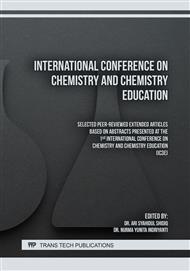p.63
p.73
p.91
p.101
p.111
p.119
p.129
p.141
p.147
Synthesis of Colloidal Silver Nanoparticles Using Alginate as Reducing and Stabilizing Agents and its Application as Antibacterial Material
Abstract:
Synthesis of colloidal silver nanoparticles has been successfully conducted through the chemical reduction technique. The synthesis used AgNO3, NaOH, and alginate as the precursor, accelerator reagent, and reducing agent and stabilizer, respectively. The effects of heating temperature, reaction time, accelerator concentration, and precursor concentration were investigated according to the localized surface plasmon resonance (LSPR) phenomenon using a UV-Vis spectrophotometer. The nanoparticle size distribution was observed via a Particle Size Analyzer (PSA). The stability of silver nanoparticles was studied for 8 weeks based on the LSPR phenomenon. Then, their antibacterial performance toward S. Aureus ATCC 25923 and E. Coli ATCC 25922 was examined. The results showed the absorbance intensities representing the number of silver nanoparticles formed were influenced by temperature, reaction time, NaOH concentration, and AgNO3 concentration. At 50°C heating, the optimum synthesis of silver nanoparticles was achieved at 50 min with a NaOH concentration of 0.013M. The higher AgNO3 concentration resulted in a greater concentration of silver nanoparticles produced. From the PSA characterization, the average particle sizes for the samples were 1.82 nm and 1.30 nm for AgNO3 concentrations (% w/w; AgNO3/Alginate) of 1.6% and 2.4%, respectively. Based on the LSPR phenomenon, colloidal silver nanoparticles were stable in storage for 8 weeks at room temperature. The increase in the concentration of silver nanoparticles within colloidal could enhance antibacterial performance against S. Aureus and E. Coli. Accordingly, silver nanoparticles synthesized with alginate as a stabilizer have the potential as an antibacterial compound for medical applications.
Info:
Periodical:
Pages:
119-127
Citation:
Online since:
November 2023
Keywords:
Price:
Сopyright:
© 2023 Trans Tech Publications Ltd. All Rights Reserved
Share:
Citation:



